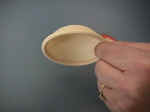
|
|
Diaphragm
A diaphragm is a latex-covered, flexible ring that fits inside the vagina, covering the cervix.
It prevents pregnancy by keeping sperm away from the cervix (the latex is impenetrable), and by holding spermicidal cream up against the cervix so that the few sperm who successfully find their way around the diaphragm are eliminated by the spermicide.
It can be inserted up to several hours prior to intercourse, and should remain in place for at least 6 hours after intercourse. If multiple episodes of intercourse occur, additional contraceptive cream may be placed in the vagina, but diaphragm should not be dislodged.
The diaphragm is very effective, with only about 5 failures per 100 women per year. Reasons for failure include non-use, improper positioning, or suboptimal use in addition to simple method failure.
Diaphragms should be individually fitted. One commonly-used size is a 65 mm diaphragm (65 mm in diameter), but sizes range from 60 to 95 mm. A properly-fitted diaphragm will cover the cervix completely, will not move in the vagina, and will be so comfortable that the woman will not know that she is wearing it. Should a pelvic aching occur several hours after insertion, the diaphragm is too large and a smaller one should be substituted. If the woman complains that the diaphragm is uncomfortable or painful for her, the size should be rechecked and changed. Her partner should not be able to feel the diaphragm under ordinary circumstances.
To remove the diaphragm, insert a finger into the vagina to hook the rim of the cervix. Pull it straight out and the flexible rim will fold as it comes out.
After each use, the diaphragm should be washed with warm water and soap, rinsed well, and allowed to dry before returning it to its' case.
Women with latex allergy cannot use the diaphragm as it will cause a reaction. There are non-latex diaphragms available, but they may prove difficult to obtain.
Women who are sensitive to nonoxynol-9, the active ingredient in spermicidal creams, may or may not tolerate the diaphragm.
A diaphragm is generally a good choice for women for whom a 5% failure rate each year is acceptable. It offers reasonably reliable contraception when needed without the potential side effects of hormonal contraception and infectious complications of IUDs. It has less of an "artificial" feel than condoms.
A diaphragm is generally a poor choice for women who are relatively inexperienced sexually as it requires a moderate degree of manual dexterity, moderate familiarity with external and internal reproductive anatomy, and sexual circumstances that allow for either pre-positioning or a brief interruption in lovemaking in order to place the diaphragm correctly.
Bureau of Medicine and
Surgery |
Operational Obstetrics
& Gynecology - 2nd Edition |